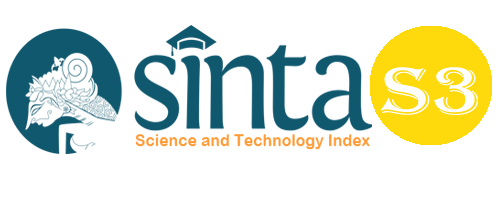Training on Introduction to Platforms and Utilization of Social Media in Online Business for MSME Actors Students of SMK Alwashliyah 2 Simalungun Regency
Abstract
Given the blossoming essence of social media marketing, literature does not delve into the complexities and consequences of small and medium-sized enterprises (SMEs). This paper seeks to advance awareness and provide an extensive analysis of the inspiration and efficiency benefits of social media provided by small and medium-sized businesses through a digital economy analysis. The conceptual analysis shows that interactivity, compatibility, and cost-effectiveness are reasons for social media use, ultimately providing advantages. SMEs of Facebook and Twitter profiles are used to analyze the conceptual paradigm suggested. This research reveals that the interdependencies of social media's motives and the consequences of social media use are optimistic but sporadic across small and medium-sized companies. SMEs selling physical goods prefer to use social media on cost-effective motivations, whereas small and medium-sized businesses tend to see interactivity as the main incentive. Furthermore, the study results indicate that Facebook and Twitter in a two-site story generate success gains for small and medium-sized enterprises' users. The study offers future analysis and management priority problems that strongly affect the academic and practice culture. Obviously, despite any bottlenecks in use, SMEs in developing markets tend to reap expanded social media gains through multi-platform marketing activities.
Keywords
Full Text:
PDFReferences
Abou-Shouk, M., Megicks, P. and Lim, W.M. (2013), “Perceived benefits and e-commerce adoption by SME travel agents in developing countries evidence from Egypt”, Journal of Hospitality and Tourism Research, Vol. 37 No. 4, pp. 490-515.
Ainin, S., Parveen, F., Moghavvemi, S., Jaafar, N.I. and Mohd Shuib, N.L. (2015), “Factors influencing the use of social media by SMEs and its performance outcomes”, Industrial Management and Data Systems, Vol. 115 No. 3, pp. 570-588.
Aladwani, A.M. (2015), “Facilitators, characteristics, and impacts of Twitter use: theoretical analysis and empirical illustration”, International Journal of Information Management, Vol. 35 No. 1, pp. 15-25.
Ashley, C. and Tuten, T. (2015), “Creative strategies in social media marketing: an exploratory study of branded social content and consumer engagement”, Psychology and Marketing, Vol. 32 No. 1, pp. 15-27.
Derham, R., Cragg, P. and Morrish, S. (2011), “Creating value: an SME and social media”, Proceedings of the Pacific Asia Conference on Information Systems (PACIS), Paper 53, AIS Electronic Library, pp. 1-9.
Dessart, L., Veloutsou, C. and Morgan-Thomas, A. (2015), “Consumer engagement in online brand communities: a social media perspective”, Journal of Product and Brand Management, Vol. 24 No. 1, pp. 28-42.
Dong-Hun, L. (2010), “Korean consumer and society: growing popularity of social media and business strategy”, SERI Quarterly, Vol. 3 No. 4, pp. 112-117.
Elaluf-Calderwood, S., Kietzmann, J. and Saccol, A.Z. (2005), “Methodological approach for mobile studies: empirical research considerations”, 4th European Conference on Research Methodology for Business and Management Studies, Academic Conferences Limited, Paris, pp. 133-140.
Foux, G. (2006), “Consumer-generated media: get your customers involved”, Brand Strategy, Vol. 8 No. 1, pp. 38-39.
Goldfarb, A. and Tucker, C. (2011), “Online display advertising: targeting and obtrusiveness”, Marketing Science, Vol. 30 No. 3, pp. 389-404.
Gu, F.F., Hung, K. and Tse, D.K. (2008), “When does Guanxi matter? Issues of capitalization and its dark sides”, Journal of Marketing, Vol. 72 No. 4, pp. 12-28.
Hasbullah, et al. (2018). Communication Pattern of Wilayatul Hisbah, Lhokseumawe City in Implementing Amar Makruf Nahi Mungkar. Budapest International Research and Critics Institute-Journal (BIRCI-Journal). P. 194-205.
Hanna, R., Rohm, A. and Crittenden, V.L. (2011), “We’re all connected: the power of the social media ecosystem”, Business Horizons, Vol. 54 No. 3, pp. 265-273.
Hawn, C. (2009), "Take two aspirin and tweet me in the morning: how Twitter, Facebook, and other social media are reshaping health care", Health Affairs, Vol. 28 No. 2, pp. 361-368.
Hoffman, D.L. and Fodor, M. (2010), “Can you measure the ROI of your social media marketing?”, MIT Sloan Management Review, Vol. 52 No. 1, p. 41.
Hsu, C., Lu, H. and Hsu, H. (2007), “Adoption of the mobile internet: an empirical study of multimedia message services (MMS)”, The International Journal of Management Science, Vol. 35 No. 6, pp. 715-726.
Hughes, D.J., Rowe, M., Batey, M. and Lee, A. (2012), “A tale of two sites: Twitter vs Facebook and the personality predictors of social media usage”, Computers in Human Behavior, Vol. 28 No. 2, pp. 561-569.
Kaplan, A.M. and Haenlein, M. (2010), “Users of the world, unite! The challenges and opportunities of social media”, Business Horizons, Vol. 53 No. 1, pp. 59-68.
Kietzmann, J.H., Silvestre, B.S., McCarthy, I.P. and Pitt, L.F. (2012), “Unpacking the social media phenomenon: towards a research agenda”, Journal of Public Affairs, Vol. 12 No. 2, pp. 109-119.
King, R.A., Pradeep, R. and Victoria, D.B. (2014), “What we know and don’t know about online word-of-mouth: a review and synthesis of the literature”, Journal of Interactive Marketing, Vol. 28 No. 3, pp. 167-183.
Knoll, J. (2016), “Advertising in social media: a review of empirical evidence”, International Journal of Advertising, Vol. 35 No. 2, pp. 266-300.
Korda, H. and Itani, Z. (2013), “Harnessing social media for health promotion and behavior change”, Health Promotion Practice, Vol. 14 No. 1, pp. 15-23.
Kumar, A., Bezawada, R., Rishika, R., Janakiraman, R. and Kannan, P.K. (2016), “From social to sale: the effects of firm-generated content in social media on customer behaviour”, Journal of Marketing, Vol. 80 No. 1, pp. 7-25.
Kwok, L. and Yu, B. (2013), “Spreading social media messages on Facebook an analysis of restaurant business-to-consumer communications”, Cornell Hospitality Quarterly, Vol. 54 No. 1, pp. 84-94.
Lovejoy, K., Waters, R.D. and Saxton, G.D. (2012), "Engaging stakeholders through Twitter: How nonprofit organizations are getting more out of 140 characters or less", Public Relations Review, Vol. 38 No. 2, pp. 313-318.
McCann, M. and Barlow, A. (2015), “Use and measurement of social media for SMEs”, Journal of Small Business and Enterprise Development, Vol. 22 No. 2, pp. 273-287.
Michaelidou, N., Siamagka, N.T. and Christodoulides, G. (2011), “Usage, barriers and measurement of social media marketing: an exploratory investigation of small and medium B2B brands”, Industrial Marketing Management, Vol. 40 No. 7, pp. 1153-1159.
Ostrom, A.L., Parasuraman, A., Bowen, D.E., Patricio, L. and Voss, C.A. (2015), “Service research priorities in a rapidly changing context”, Journal of Service Research, Vol. 18 No. 2, pp. 127-159.
Quan-Haase, A. and Young, A.L. (2010), “Uses and gratifications of social media: a comparison of Facebook and instant messaging”, Bulletin of Science, Technology and Society, Vol. 30 No. 5, pp. 350-361.
Raphael Odoom, Thomas Anning-Dorson, George Acheampong, (2017) "Antecedents of social media usage and performance benefits in small- and medium-sized enterprises (SMEs)", Journal of Enterprise Information Management, Vol. 30 Issue: 3, pp.383-399
Ratchford, B.T. (2015), “Some directions for research in interactive marketing”, Journal of Interactive Marketing, Vol. 29 No. 1, pp. V-VII.
Saffer, A.J., Sommerfeldt, E.J. and Taylor, M. (2013). “The effects of organizational Twitter interactivity on organization–public relationships”, Public Relations Review, Vol. 39 No. 3, pp. 213-215.
Sheth, J.N. (2011), “Impact of emerging markets on marketing: rethinking existing perspectives and practices”, Journal of Marketing, Vol. 75 No. 4, pp. 166-182.
Sundar, S.S., Kalyanaraman, S. and Brown, J. (2003), “Explicating web site interactivity impression formation effects in political campaign sites”, Communication Research, Vol. 30 No. 1, pp. 30-59.
Wamba, S.F. and Carter, L. (2014), "Social media tools adoption and use by SMEs: an empirical study", Journal of Organizational and End User Computing (JOEUC), Vol. 26 No. 2, pp. 1-17.
Wang, Y.M., Wang, Y.S. and Yang, Y.F. (2010), “Understanding the determinants of RFID adoption in the manufacturing industry”, Technological Forecasting and Social Change, Vol. 77 No. 5, pp. 803-815.
Weinberg, B.D. and Pehlivan, E. (2011), “Social spending: managing the social media mix”, Business Horizons, Vol. 54 No. 3, pp. 275-282.
Whiting, A. and Williams, D. (2013), “Why people use social media: a uses and gratifications approach”, Qualitative Market Research: An International Journal, Vol. 16 No. 4, pp. 362-369.
Zappe, J. (2010), “The ROI of social media”, Journal of Corporate Recruiting Leadership, Vol. 5 No. 3, pp. 3-9.
Zeng, B. and Gerritsen, R. (2014), “What do we know about social media in tourism? A review”, Tourism Management Perspectives, Vol. 10 No. 1, pp. 27-36.
DOI: https://doi.org/10.33258/birci.v4i1.1690
Article Metrics
Abstract view : 156 timesPDF - 114 times
Refbacks
- There are currently no refbacks.

This work is licensed under a Creative Commons Attribution-ShareAlike 4.0 International License.

This work is licensed under a Creative Commons Attribution-ShareAlike 4.0 International License.

_.gif)

















_.gif)



